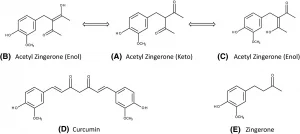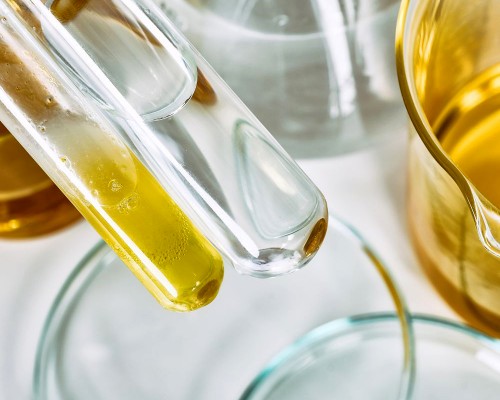Best IN LAB Ingredients (Part 1)
We’ve rounded up a few, favourite multi-tasking ingredients we use here at 1611 LABS, to provide more insight and education into them and how they function.
We’ve also highlighted in which of our 10 serums you can find them in!
BAKUCHIOL

Bakuchiol, a meroterpene, is a phenolic compound with a monoterpene side chain. It belongs to a rare group of terpenoids in which the aromatic ring system is derived from phenylpropane unit. It has no structural resemblance to retinoids, but has similar functionalities.
It helps control inflammation by inhibiting/down regulating pro-inflammatory genes and enzymes; to prevent collagen and elastin degradation and the breakdown of skin’s barrier function. Which ultimately leads to an inflammatory cascade of reactions that erode the skin’s structure – deep wrinkles, hyperpigmentation and non-elastic tissues.
Bakuchiol has also been shown to be effective against multiple pathophysiologic features of acne.
It helps correct the altered pattern of follicular keratinization; decreases sebaceous gland activity; decreases the follicular bacterial population, especially P. acnes; and helps produce an anti-inflammatory effect by inhibiting the production of extracellular inflammatory products through the inhibition of these microorganisms. (I Kurokawa et al, New developments in our understanding of acne pathogenesis and treatment, Experimental Dermatology, 18 821–832 (2009)).
We use 99.5% pure Bakuchiol, obtained from the edible seeds of Psoralea corylifolia to directly act on the causes of skin irritation, and help heal and repair stressed and damaged skin.
Find in Formula 8|v.5 Clarifying Balancing Treatment Oil
INULIN
Inulin is a clinically proven natural prebiotic that feeds selective organisms of the microbiota in order to restore its balance. By reinforcing the microbiota, it helps improve short and long term hydration.
We use a combination of two types of inulin differing in molecular chain length. These are extracted from chicory/sunroot root and agave pinas; and can only be metabolized by organisms carrying the inulinase enzyme. Due to this, inulin acts as a prebiotic and only feeds select beneficial organisms which in turn provide food for others, thus supporting the microbiota.
They help –
- Hydrate the skin via the skin microbiota
- Boost the recovery of the protective and healthy skin microbiota
- Restore the skin microbiota of acne-prone skin
Find in Formula 10|v.5 Prebiotic Urban Defence Treatment
DIGLUCOSYL GALLIC ACID
Diglucosyl Gallic Acid is a new generation of skin melanoregulator molecule, activated by the stratum microbium.
It contains the patented THBG ingredient (Tri Hydroxy Benzoic acid alpha-Glucosides) that is partially converted by the skin microbiote into THBA (Tri Hydroxy Benzoic Acid – a natural inhibitor of tyrosinase), once applied to skin.
The partially converted THBA acts in synergy with THBG to help block the melanogenesis process at multiple levels, therefore controlling pigmentation and reducing pigmented spots. It also protects the skin and prevents inflammation.
The multiple pathways are –
- Inhibiting ROS (reactive oxygen species) production
- Preventing UV-induced DNA damages
- Decreasing the expression of MITF, the transcription factor involved in the genesis of melanin synthesis pathway
- Reducing the expression of PGE2 (Prostaglandin-E2 production). PGE2 is produced by human epidermal keratinocytes in response to UVB. It stimulates the formation of dendrites in melanocytes
- Controlling the Nf-kB pathway to reduce inflammation
- Saturating keratinocytes receptors to stop melanin transfer – the transfer of melanin from melanosomes to keratinocytes requires free galactose receptors on the surface of keratinocytes. Saturating & blocking the keratinocytes galactose receptors, prevents melanin transfer
Find in Formula 5|v.8 Multi Pathway Depigmenting Treatment
GREAT BURDOCK PLANT EXTRACT
Sourced from the core of the roots of great burdock plant, using aeroponic culture (higher content of root metabolites compared to traditional root extracts); this unique plant extract helps support the skin microbiota & prevent microbial imbalance for a functional & protective skin barrier.
There are various biotopes tightly associated to the epidermis surface where the skin microbiota lives, consisting of numerous bacterial, viral, fungal & other communities of microorganisms. As such, the skin is the site of balanced cell-microbe interactions & any disturbance of this homeostasis may lead to skin disorders such as barrier function disruption or excessive inflammation, thus increasing skin reactivity & discomfort.
Toll-like receptors (TLRs) are important microbes pattern-recognition receptors found in skin cells that induce pro-inflammatory cytokines IL-8 (interleukin 8) & antimicrobial peptides hBD2 (human beta defensin 2) secretion.
When skin-microbiota homeostasis is imbalanced due to exogenous or endogenous factors; TLR-induced dialogue leads to an excessive production of such mediators & could lead to certain skin disorders.
Great burdock plant extract helps protect from the overproduction of these stimulatory signals for better cohabitation.
Find in –
Formula 1|v.7 Intense Moisturisation & Anti Dehydration Complex
Formula 3|v.13 Clarifying Treatment Concentrate
Formula 10|v.5 Prebiotic Urban Defence Treatment
BIDENS PILOSA EXTRACT
This is a supercritical apolar extract of Picão Preto (Bidens pilosa), standardized in phytol. The extraction of supercritical fluids allows obtaining active ingredients from a plant matrix, resulting in collection of purified compounds in higher concentration. It is a stable, plant-based extract for the treatment of aging skin; similar to the action of retinoids.
Retinoids do their job by binding to nuclear receptors, known as RARs (Retinoic Acid Receptors) and RXRs (Retinoids X Receptors); forming a compound that has the ability to connect to specific regions of DNA, known as RARE (Retinoic Acid Responsive Element). This starts the process of transcriptional activity related to the action of retinoids such as epidermal proliferation and differentiation, proliferation of fibroblasts as well as collagen, elastin and glycosaminoglycans production; essential components of the extracellular matrix. (Beckenbach L, Baron JM, Merk HF, Löffler H, Amann PM. Retinoid treatment of skin diseases. Eur J Dermatol 2015: 25: 384-391).
Our extract presents retinoid like behaviour by binding to the RXR receptor and reducing the RAR expression; while increasing the RXR expression resulting in effective anti-aging and anti-photoaging action –
- Helps stimulate cellular proliferation, differentiation and extracellular matrix production by upregulating gene expression of EGFr (epidermal growth factor receptor) and pro-collagen; thus increasing the production of collagen type I and IV, elastin and the growth factors FGF-β (fibroblast growth factor beta) and TGF-β (tissue growth factor beta), in addition to inhibiting the production of MMP-1 (metalloproteinase-1).
- Helps provide antioxidant activity and regulate cell senescence by stimulating the production of SOD (superoxide dismutase) and CAT (catalase); in addition to reducing the production of free radicals and lipoperoxidation and stimulate gene expression of SIRT6 (Sirtuin 6).
- Provides soothing effect by regulating the activity of key inflammatory mediators – AP-1 transcription factor (Activator protein 1), COX-2 (Ciclo-oxigenase-2), PGE2 (Prostaglandin E2) and LTB4 (Leukotriene B4).
- Helps with hyperpigmentation by reducing the production of alpha-MSH (alpha-melanocyte stimulating hormone) and, as a result the production of melanin.
- Helps control oiliness by reducing the production of DHT (dihydrotestosterone), an important mediator in the production of sebum in the skin.
Find in Formula 9|v.8 Cellular Repair Treatment Oil
AMELIOX OA
Ameliox OA is a liposomal preparation combining carnosine, an antioxidant and anti-glycation substance with 2 powerful oil-soluble antioxidants (silymarin and tocopherol). It is able to inhibit lipid peroxidation and so, prevents and slows down the process; thereby delaying the glycation process and preventing oxidative aging.
Glycation is a slow naturally-occurring process which affects the structure and activity of proteins. Also called Maillard or browning reaction; it is a process where reducing sugar molecules react with free amino groups of proteins leading to the formation of irreversible cross-linked molecules called AGE (advanced glycation end-products). Oxidative stress factors and notably lipid peroxidation accelerate the glycation process.
Other factors can also promote the glycation process such as high glucose levels, aging (notably after 35), oxidative stress such as UV-induced lipid peroxidation which leads to the formation of malondialdehyde, a reactive compound.
In skin, glycation results in the formation of rigid bridges between structural proteins such as collagen and elastin; making the dermis proteins stiffer and more brittle – affecting their interactions with other cells. This results in loss of elasticity and suppleness of the skin, and appearance of wrinkles.
Carnosine, a dipeptide which occurs naturally in our body, is well-known for its anti-glycation activity. It inhibits the cross-linking of proteins induced by reducing sugars and reactive aldehydes such as malondialdehyde.
It acts as a glycation target, and competes with the skin proteins and therefore, protects collagen and elastin fibers. In contrast to AGE, the resulting glycated carnosine is not deleterious and not toxic.
Carnosine is combined with silymarin and tocopherol to reinforce its effect.
Silymarin is the major active substance of milk thistle, a flowering plant of the daisy family. This polyphenol supports physiological antioxidants and radical scavengers such as glutathione and superoxide dismutase and is also able to capture and neutralize free radicals. It inhibits lipid peroxidation and inflammation as well as the release of histamine.
Tocopherol is naturally present in the skin being the major lipid-soluble antioxidant. Located in cellular membranes, it protects skin lipids against peroxidation and maintains the barrier function.
The liposomal form found in Ameliox OA increases the bioavailability of all compounds thanks to the small size of the liposomes and their high affinity to the stratum corneum. This results in an enhanced and long-lasting activity.
Find in –
Formula 4|v.7 Vitamin C AOX Network
Formula 5|v.8 Multi Pathway Depigmenting Treatment
Formula 6|v7 Cellular Repair Retinal Complex
ACETYL ZINGERONE

Acetyl Zingerone is a microbiome friendly, superior antioxidant that has a performance profile against ROS (reactive oxygen species) by being able to neutralize conventional free radicals (ROO•, HO•) as an antioxidant, physically quench excited states (singlet oxygen 1 O2) and scavenge strong nucleophiles (ONOO-) through carbonyl addition with high efficiencies.
Sun exposure on skin generates an abundance of ROS that skin’s own antioxidant defenses become overwhelmed easily, creating an environment of oxidative stress within the tissue. Excess formation of ROS is strongly linked to events in skin that cause photoaging and are detrimental to skin’s overall health as we age. ROS (reactive oxygen species) upregulates the MMP-1 enzyme, which chemically degrades collagen, whilst simultaneously inhibiting production of new collagen in a process that correlates with many signs of photoaging, including development of deep and fine wrinkles as well as skin laxity.
Inspired by curcumin and zingerone from ginger, the molecular structure of AZ is unique. It exists in keto-enol tautomers; which enables the molecule with unique capabilities to attenuate different forms of ROS with high efficiency through multiple pathways. These include efficient and direct neutralization of the most reactive forms of ROS; high selectivity for iron as a chelator; and the capability to physically quench one of skin’s most potent endogenous generators of ROS— AGEs (advanced glycation end-product)— during sun exposure.
It helps reduce both immediate & dark skin damage and maintains the integrity of ECM to help reduce the appearance of fine line & wrinkles; it also helps with uneven pigmentation and restore skin barrier function.
Find in –
Formula 4|v.7 Vitamin C AOX Network
Formula 6|v7 Cellular Repair Retinal Complex


